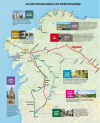The legal framework is established by an earlier Law :
https://www.boe.es/buscar/doc.php?id=BOE-A-1996-14651
The
Ley 3/1996, de 10 de mayo (1996).
It states as its basic principle :
Artículo 1.
...
2. A los efectos de la presente Ley, se entiende como Camino de Santiago todas las rutas históricas reconocidas documentalmente.
(emphases mine)
However :
3. La ruta principal, dentro del marco de la presente Ley, es el «Camino francés», bien de interés cultural, según la delimitación de su territorio histórico, recogida en la Resolución de 12 de noviembre de 1992 de la Dirección General del Patrimonio Histórico y Documental.
4. Las otras rutas que se enmarcan en la denominación general de «Camino de Santiago» se corresponden con las actualmente conocidas como «Camino portugués», «Ruta de la plata», «Camino del norte», «Camino de Fisterra», «Camino inglés» y «Ruta del mar de Arousa y Ulla». Su delimitación y deslinde se realizará con arreglo a lo dispuesto en la presente Ley. Una vez deslindadas, les será de aplicación la protección prevista en la Ley del Patrimonio Cultural de Galicia para los bienes catalogados.
... means that extra legal protections are provided to any Camino route that has been recognised / officially established as one at the State level.
However, Article 1.2 establishes that
every historically documented route is defined as being a part of the Way of Saint James.
The Way of Saint James is further defined, from a legal perspective, in :
Artículo 4.
El Camino de Santiago constituye un bien de dominio público de carácter cultural incluido en la categoría de territorio histórico. Como tal le será de aplicación la legislación general autonómica en esta materia.
The whole of this Law is interesting.
It is the
Consejería de Cultura which seems to decide which Historic Camino routes are to be given particular legal protections, with the advice of the C
omité Asesor del Camino de Santiago that is established by this Law.
-------------
So that it would seem that these laws make certain particular routes
legally established routes of the Camino rather than "official"
per se -- and that additionally, from the
legal standpoint, an "officially recognised route" is
any route of the Way of Saint James that is historically documented as being such, including both the legally established routes and those not legally established. So that
would exclude the more poorly travelled tertiary routes and variants, as well as the network of individual routes from every village at least until they reach a junction with a historic route.
The wording of the Law plus the definition of the Camino as a "
cultural good" does mean that it is legal to create such infrastructures as waymarkings (yellow arrows etc.) and Albergues and so on upon some secondary Camino routes not among those legally established, but that more extensive infrastructural work at the Regional or State level is only possible on the legally established routes, unless the
Consejería de Cultura should recognise them as such and so undertake the responsibilities and expenses of such work.
The individual municipalities can of course do some of their own work on sections of non-legally established routes, but the Law establishes conditions and limitations for such work on those routes that have been.
---
This is coherent with the definitions of the more recent Law :
TÍTULO VI
Los Caminos de Santiago
Artículo 73. Concepto de los Caminos de Santiago.
1. Los Caminos de Santiago están formados por el conjunto de rutas reconocidas documentalmente de las que puede testimoniarse su uso como rutas de peregrinación de largo recorrido y que estructuran, conforman y caracterizan el territorio que atraviesan.
2. Las rutas principales de los Caminos de Santiago son: el Camino Francés; el Camino del Norte, ruta de la costa y ruta del interior, también conocido como Camino Primitivo o de Ovedo; el Camino Inglés; el Camino de Fisterra y Muxía; el Camino Portugués, interior y de la costa; la Vía de la Plata o Camino Mozárabe; y el Camino de Invierno.
3. Podrán ser reconocidas como Camino de Santiago aquellas rutas de las que se documente y justifique convenientemente su historicidad como rutas de peregrinación a Santiago de Compostela y su influencia en la formalización de la estructura del territorio por el que transcurren.
Which states that all historically known routes to Santiago form the Way of Saint James, though it limits that status to the long distance routes (and the 1996 Law defined them as walking routes).
It states certain routes as being the "principal" routes, but not the only ones, and that other routes can be established legally as such for the purposes of these Laws.

 www.elcorreogallego.es
www.elcorreogallego.es



















